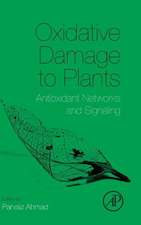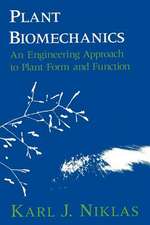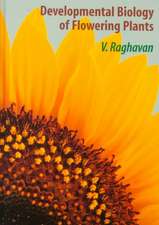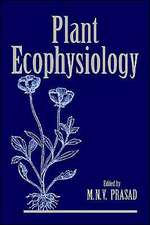Physiological Mechanisms and Adaptation Strategies in Plants Under Changing Environment: Volume 2
Editat de Parvaiz Ahmad, Mohd Rafiq Wanien Limba Engleză Paperback – 22 aug 2016
Physiological Mechanisms and Adaptation Strategies in Plants under Changing Environment, Volume 2 displays the ways by which plants utilize and integrate many common signals and subsequent pathways to cope with less favourable environmental conditions. The book also describes the use of contemporary tools for the improvement of plants under such stressed environments. Concise yet comprehensive, Physiological Mechanisms and Adaptation Strategies in Plants under Changing Environment, Volume 2 is an indispensable resource for researchers, students, environmentalists and many others in this burgeoning area of research.
| Toate formatele și edițiile | Preț | Express |
|---|---|---|
| Paperback (2) | 949.10 lei 6-8 săpt. | |
| Springer – 22 aug 2016 | 949.10 lei 6-8 săpt. | |
| Springer – 22 aug 2016 | 950.03 lei 6-8 săpt. | |
| Hardback (2) | 951.29 lei 6-8 săpt. | |
| Springer – 11 noi 2013 | 951.29 lei 6-8 săpt. | |
| Springer – 3 dec 2013 | 952.09 lei 6-8 săpt. |
Preț: 950.03 lei
Preț vechi: 1158.57 lei
-18% Nou
Puncte Express: 1425
Preț estimativ în valută:
181.78€ • 189.81$ • 150.11£
181.78€ • 189.81$ • 150.11£
Carte tipărită la comandă
Livrare economică 15-29 aprilie
Preluare comenzi: 021 569.72.76
Specificații
ISBN-13: 9781493948574
ISBN-10: 1493948571
Pagini: 410
Ilustrații: XVI, 394 p. 28 illus., 13 illus. in color.
Dimensiuni: 155 x 235 x 21 mm
Greutate: 0.58 kg
Ediția:Softcover reprint of the original 1st ed. 2014
Editura: Springer
Colecția Springer
Locul publicării:New York, NY, United States
ISBN-10: 1493948571
Pagini: 410
Ilustrații: XVI, 394 p. 28 illus., 13 illus. in color.
Dimensiuni: 155 x 235 x 21 mm
Greutate: 0.58 kg
Ediția:Softcover reprint of the original 1st ed. 2014
Editura: Springer
Colecția Springer
Locul publicării:New York, NY, United States
Cuprins
Biochemical and Molecular Approaches for Drought Tolerance in Plants.- Heavy-Metal Attack on Freshwater Side: Physiological Defense Strategies of Macrophytes and Ecotoxicological Ops.- Secondary Metabolites and Environmental Stress in Plants: Biosynthesis, Regulation and Function.- Major Phytohormones under Abiotic Stress.- Nitric Oxide: Role in Plants under Abiotic Stress.- Brassinosteroids: Improving Crop Productivity and Abiotic Stress Tolerance.- Ethylene: Role in Plants under Environmental Stress.- Scenario of Climate Changes in the Context of Agriculture.- Importance of Protective Compounds in Stress Tolerance.- Growth Patterns of Tomato Plants Subjected to Two Non-Conventional Abiotic Stresses: UV-C Irradiations and Electric Fields.- Rhizobacteria: Restoration of Heavy Metal Contaminated Soils.- Potassium and Sodium Transport Channels under NaCl Stress.- Jatropha curcas: An Overview.
Notă biografică
Dr. Parvaiz Ahmad
Department of Botany, Sri Pratap College, Srinagar, Jammu and Kashmir, India
Dr. Mohd Rafiq Wani
Department of Botany, Govt. Degree College (Boys), Anantnag, Jammu and Kashmir, India
Department of Botany, Sri Pratap College, Srinagar, Jammu and Kashmir, India
Dr. Mohd Rafiq Wani
Department of Botany, Govt. Degree College (Boys), Anantnag, Jammu and Kashmir, India
Textul de pe ultima copertă
Abiotic stress has a detrimental impact on the living organisms in a specific environment and constitutes a major constraint to global agricultural production. The adverse environmental conditions that plants encounter during their life cycle not only disturb their metabolic reactions, but also hamper their growth and development on cellular and whole plant levels. These conditions are of great concern, particularly for those countries whose economies primarily rely on agriculture. Under abiotic stresses, plants amalgamate multiple external stress cues to bring about a coordinated response and establish mechanisms to mitigate such stresses by triggering a cascade of events leading to enhanced tolerance.
Physiological Mechanisms and Adaptation Strategies in Plants under Changing Environment, Volume 2 displays the ways by which plants utilize and integrate many common signals and subsequent pathways to cope with less favourable environmental conditions.The book also describes the use of contemporary tools for the improvement of plants under such stressed environments. Concise yet comprehensive, Physiological Mechanisms and Adaptation Strategies in Plants under Changing Environment, Volume 2 is an indispensable resource for researchers, students, environmentalists and many others in this burgeoning area of research.
Physiological Mechanisms and Adaptation Strategies in Plants under Changing Environment, Volume 2 displays the ways by which plants utilize and integrate many common signals and subsequent pathways to cope with less favourable environmental conditions.The book also describes the use of contemporary tools for the improvement of plants under such stressed environments. Concise yet comprehensive, Physiological Mechanisms and Adaptation Strategies in Plants under Changing Environment, Volume 2 is an indispensable resource for researchers, students, environmentalists and many others in this burgeoning area of research.
Caracteristici
Written by a diverse group of internationally known scholars Latest results, techniques, and methods of plant mechanism and adaptation to stress research Climate change discussion related to this important subject?
Recenzii
From the reviews:
“The presentation of the topics is consistent throughout the book. A ‘Conclusions and Future Prospects’ section in each chapter encapsulates the contents of the chapter and discusses future areas of investigation. The depth of the material presented makes the work appropriate for graduate students in plant physiology courses, as either a textbook or supplementary reading. Summing Up: Recommended. Graduate students and researchers/faculty.” (J. L. Hatfield, Choice, Vol. 51 (9), May, 2014)
“The presentation of the topics is consistent throughout the book. A ‘Conclusions and Future Prospects’ section in each chapter encapsulates the contents of the chapter and discusses future areas of investigation. The depth of the material presented makes the work appropriate for graduate students in plant physiology courses, as either a textbook or supplementary reading. Summing Up: Recommended. Graduate students and researchers/faculty.” (J. L. Hatfield, Choice, Vol. 51 (9), May, 2014)


















